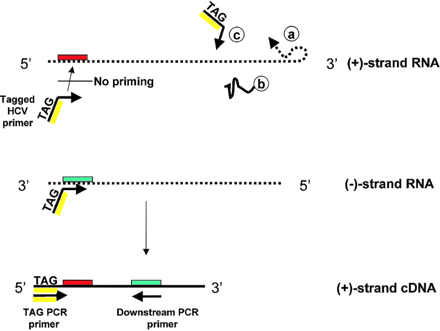A Tale of Two Strands: Reverse-Transcriptase Polymerase Chain Reaction Detection of Hepatitis C Virus Replication
Fig. 2. Improved specificity of rTth RP-PCR for detection of minus-strand RNA. (A) Reverse transcription of RNA into cDNA is performed at 70°C in the presence of Mn2+. Because of the higher temperature, there is greatly reduced (a) self-priming, (b) random priming, or (c) false priming. Thus, there is very little nonspecific cDNA synthesized and transferred into the PCR reaction. This results in 1,000- to 10,000-fold specificity for detection of the minus-strand RNA. (B) Correct detection of minus-strand RNA. As in (A), reverse transcription of RNA into cDNA is performed at 70°C in the presence of Mn2+. The tagged HCV primer results in synthesis of a positive-strand cDNA. In the subsequent PCR reaction, the reverse-transcriptase activity of the rTth polymerase is eliminated by the addition of ethyleneglycoltetraacetic acid and Mg2+ is added to activate the DNA polymerase activity. The positive-strand cDNA is now amplified by the tag primer (through its tag sequence) and the downstream HCV primer.





